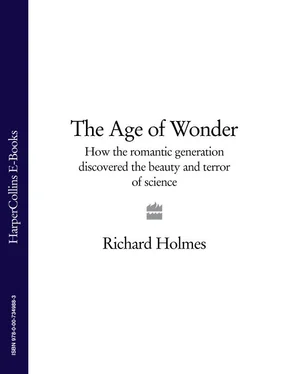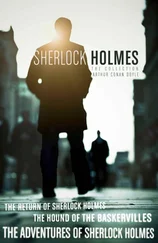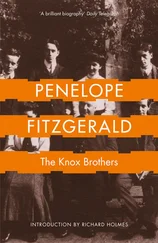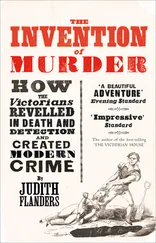The dramatic implications of these ideas were soon picked up by journalists and popularisers. The following year Bonnycastle assessed the situation in the first edition of his Introduction to Astronomy: ‘Mr Herschel is of opinion that the starry heaven is replete with these nebulae, and that each of them is a distinct and separate system, independent of the rest. The Milky Way he supposes to be that particular nebula in which our sun is placed; and in order to account for the appearance it exhibits, he supposes its figure to be much more extended towards the apparent zone of illumination than in any other direction…These are certainly grand ideas, and whether true or not, do honour to the mind that conceived them.’ 189
Also contained in Herschel’s revolutionary paper of 1785 were the seeds of a new, long-term project. He was planning the building of a monster forty-foot telescope, with a four-foot mirror. This would be the biggest and most powerful reflector in the world. With this he believed he could resolve once and for all the problem of the nebulae-whether they were other galaxies far beyond the Milky Way, or merely gas clouds within it. He would also have a better chance of establishing the true distance of the stars, through the measurement of stellar parallax. Above all he believed he would be able to understand how the stars were created, and whether the whole universe was changing or evolving according to some definite law or plan. Finally, he believed he might establish if there were observable signs of extraterrestrial life, a discovery which would have enormous impact on philosophical and even theological beliefs.
There was one other small, but revolutionary, departure in his 1785 paper. For the first time William Herschel carefully credited Caroline in print with a small ‘associate nebula’ in Andromeda. It was a previously unknown cluster ‘which my Sister discovered on August 27 1783 with a Newtonian 2 foot sweeper’. It was not in Messier’s annual catalogue La Connaissance des Temps, so this was Caroline Herschel’s first new addition to the universe. 190
♣ Caroline eventually wrote out two versions of this memoir, the first in summer 1821, when she was seventy, and the second in 1840. She also destroyed two sections of the original record which she did not want read by other family members. A composite version was edited by her great-niece, Mrs John Herschel, and published by Murray in 1769. The manuscript still exists in the private collection of John Herschel-Shorland. The individual Memoirs have been meticulously published by Michael Hoskin, as Caroline Herschel’s Autobiographies (2003). William wrote a ‘Memorandum of my Life’ when he was nearly sixty, but this was a sort of professional CV for fellow scientists, comparatively short and characteristically reserved (Herschel, Scientific Papers 1, p.xiii). For full details see the Bibliography.
♣ Three of William Herschel’s works are currently available on CD. They are his Oboe Concertos in C major and E-flat major, and his Chamber Symphony in F major (Newport Classics, Rhode Island, USA, 1995). They are notable for their light musical touch and fine, sprightly melodic lines, sometimes with a certain melancholy in the slower passages. The rapid, complex orchestration around the solo oboe in the concertos is handled with great confidence, and suggests Herschel’s ability to manage patterns and counterpoint. This was a conceptual skill which he seemed to transfer (visually) to the patterning of stars and constellations. He moved from earthly music to the music of the spheres.
♣ A typical brass eighteenth-century orrery showed the sequence of six known planets: Mercury, Venus, Earth, Mars, Jupiter (with moons) and Saturn (with rings) orbiting around a central sun (sometimes operated by clockwork and illuminated by candles). Flamsteed showed all constellations-such as Herschel’s early favourites Orion, Andromeda and Taurus-against mythological engravings of their signs: the Hunter, the Goddess, the Bull. His Atlas Coelestis catalogued 3,000 stars; the modern Hubble telescope has identified some nineteen million. But the presentation of the night sky as a curved dome of mythological constellations is still quite usual, as for instance in the magnificently restored curved ceiling of Grand Central Station, New York.
♣ The use of horse-dung moulds for casting metal mirrors continued well into the twentieth century, with the 101-inch mirror of the Mount Wilson telescope in California, cast in Paris in 1920 and eventually used by Edwin Hubble to confirm Herschel’s theories about the nature and distance of galaxies in 1922. See Gale Christianson, Edwin Hubble: Mariner of the Nebulae (1995). Precision was never easy to obtain: the mirror of the modern orbiting Hubble Space Telescope was found to be two micrometres too flat at the edges, an error which cost $1.5 billion to correct in 1992.
♣ In describing the rebel angel’s enormous glowing shield, Milton contrives in Paradise Lost a beautiful reference to Galileo’s refractor telescope and the view he achieved of the moon.
…The broad circumference
Hung on his shoulders like the Moon, whose orb
Through optic glass the Tuscan artist views
At evening from the top of Fiesole.
Or in Val d’Arno, to descry new lands,
Rivers, or mountains in her spotty globe.
( Paradise Lost, Book I, lines 288-. See also Book III, lines 589-, and Book 5, 262-)
Milton here includes Galileo’s confirmation of an imperfect, ‘spotty’ globe, as described in his famous treatise The Starry Messenger (1610). His observations of rugged lunar mountains and irregular craters proved that not all celestial objects were perfect, and so the theologians were wrong about the nature of God’s creation (as well as about the movement of the earth around the sun). More subtly, Milton puts forward the notion of the moon as the earth’s cosmic shield, battered by many warlike blows from meteors. A modern poet might assign that task to Jupiter. As a young man Milton claimed to have met Galileo in 1638, during his tour of Italy, and discussed the new cosmology. ‘There it was that I found and visited the famous Galileo, grown old, a prisoner to the Inquisition, for thinking in astronomy otherwise than the Franciscan and Dominican licensers thought’-John Milton, Areopagitica (1644).
♣ The Great Andromeda galaxy, now classified as M.31, is 2.8 billion light years away, part of the laconically named ‘Local Group’ of galaxies, which includes our Milky Way. The Orion nebula, M.42, hangs just below the three stars of Orion’s belt, and is a gaseous star-cluster within our own galaxy, a mere 1.6 thousand light years away, sometimes known as the Sword of Orion. The M. numbers were assigned by Herschel’s contemporary, the Parisian astronomer Charles Messier, in an annual publication known as La Connaissance des Temps. His catalogue for 1780 held sixty-eight deep-sky objects. No astronomer yet had the least idea of the enormous distances involved, so huge that they cannot be given in terms of conventional ‘length’ measurement at all, but either in terms of the distance covered by a moving pulse of light in one year (‘light years’), or else as a purely mathematical expression based on parallax and now given inelegantly as ‘parsecs’. One parsec is 3.6 light years, but this does not seem to help much. One interesting psychological side-effect of this is that the universe became less and less easy to imagine visually. Stephen Hawking has remarked, in A Brief History of Time (1988), that he always found it a positive hindrance to attempt to visualise cosmological values.
♣ As with road directions, a diagram is a much better way to explain parallax than a written sentence. But it is interesting to try. Parallax is basically a trigonometrical calculation applied to the heavens. Stellar parallax is a calculation which is obtained by measuring the angle of a star from the earth, and then measuring it again after six months. The earth’s movement during that interval provides a long base line in space for triangulation. So the difference in the two angles of the same star (the parallax) after six months can be used in theory to calculate its distance. In fact single stars are so far away that they did not provide sufficient parallax to be measured with the techniques available at the time. Herschel thought that double stars might provide a more obvious parallax, by triangulating their movements against each other, as observed over six months from earth. In fact no sufficient parallax was observed until the nineteenth century, when Thomas Henderson measured the distance to the nearest star, Alpha Centauri, as 4.5 light years in 1832, and the German astronomer Friedrich Bessel measured the distance to 61 Cygni as 10.3 light years in 1838. As both published their results in 1838, there was a priority dispute. The first galactic distances were established by Edwin Hubble, using the celebrated ‘red-shift’ method in the 1920s. It is intriguing that towards the end of his career Hubble thought that ‘red-shift’ might be less reliable than he had originally supposed, and galactic distances are still an area of dispute, although the ‘age’ of the entire universe is currently agreed at 13.7 billion years. Andromeda, incidentally, is ‘blue-shifted’, and therefore approaching our Milky Way, with which it will eventually collide-or cohabit.
Читать дальше












